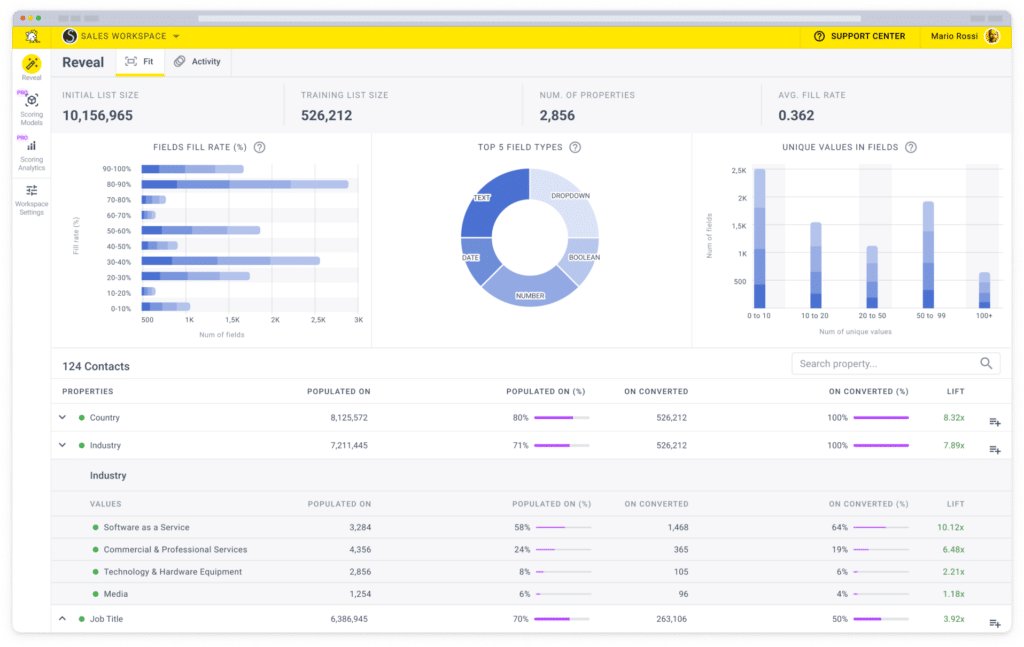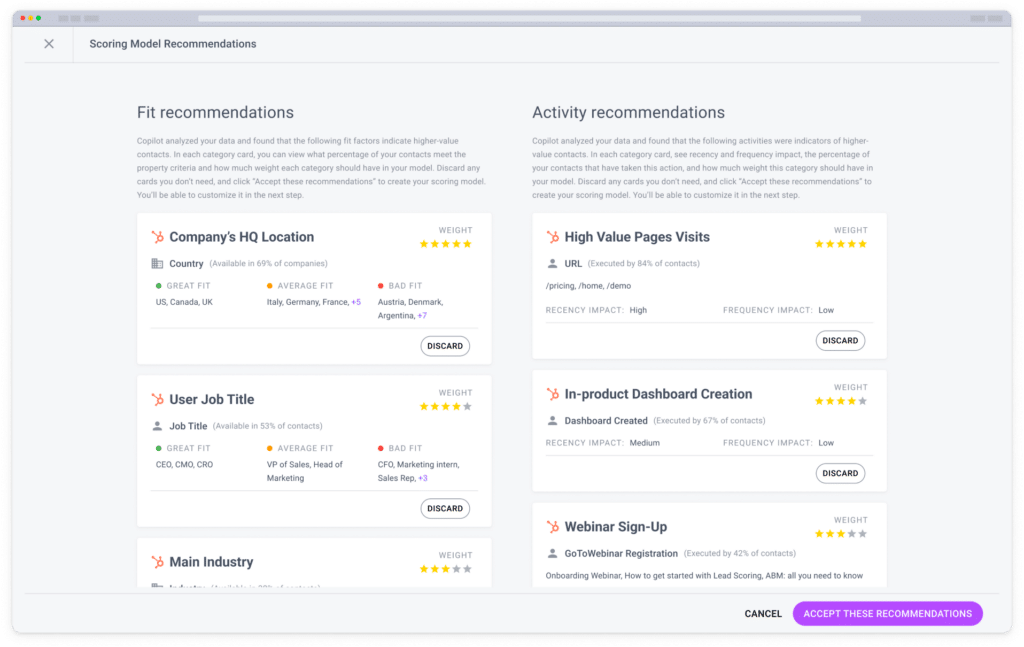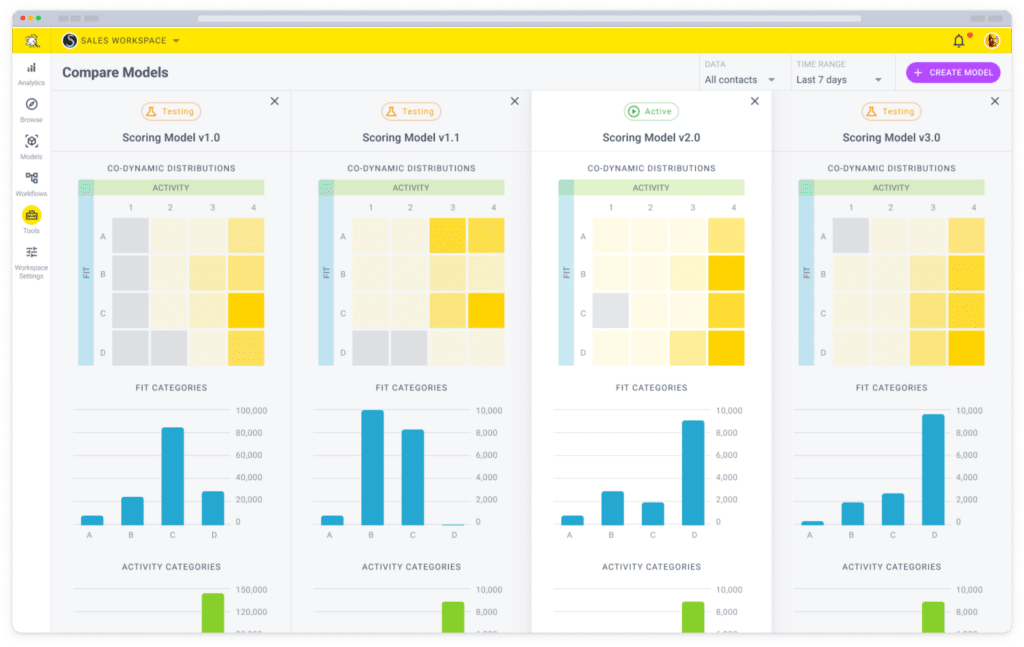Tracking website visitors allows you to uncover meaningful insights into how online users behave, as well as their preferences and interests.
These insights allow you to make data-driven decisions on how you’ll improve their navigation, personalize their experience, and measure the effectiveness of your marketing campaigns.
The better you know who visits your site and understand their behavior once they land on it, the easier it will be to improve your lead generation efforts and conversion rates.
This guide will help you learn how to effectively track website visitors and why you need website visitor data when scoring leads.
Let’s get started!
Basics of Tracking Website Visitors
Website visitor tracking involves monitoring and collecting both qualitative and quantitative data about your web visitors.
Quantitative data offers insights into visitor behavior and engagement with different elements of your website, allowing you to assess the effectiveness of your marketing campaigns.
This data includes traffic metrics, source and referral data, behavioral data, and conversion tracking.
That said, tracking web visitors is evolving and has gone beyond monitoring web traffic alone.
The growth of different digital channels and devices is prompting marketers and business owners to embrace multichannel tracking.
It helps you monitor the behavior of website visitors on different platforms and touchpoints, allowing you to have a comprehensive outlook of the customer journey and improve their buying experience.
There’s also a shift towards focusing on user-centric metrics such as:
- Individual user session duration
- The level of engagement
- Number of repeat visits
These metrics help in measuring the quality of user experience and provide insights into areas that need optimization.
Importance and Benefits of Tracking Website Visitors
Here are three ways web visitor tracking can help you improve lead generation and conversions.
1. Identify Content Assets That Resonate With Your Audience
Tracking website visitors helps you identify the pages and content they engage with.
Understanding your audience’s content preferences at different stages of their buying journey allows you to create targeted content that resonates with them, boosting engagement and conversions.
2. Qualify Leads Based on Buyer Intent
Analyzing user behavior helps marketers identify signs of a potential customer’s willingness to buy. These insights allow them to run targeted marketing and nurturing campaigns to improve conversions. By collaborating with nearshore software development companies, you can enhance your tech capabilities and implement these strategies more effectively.
3. Personalization and Segmentation
Businesses can track website activity to adapt the user experience to individual preferences and actions.
Visitor tracking data allows marketers to segment their audiences and deliver content, product recommendations, and promotions customized for each segment. If you run an e-commerce store and work with Shopify development companies to create it, such data can provide invaluable insights into customer behavior.
Running personalized campaigns helps improve user engagement, drive conversions, and improve customer retention and loyalty.
On the other hand, qualitative data helps you understand the motives behind visitor behavior.
It provides more context about visitor preferences, experiences, and perceptions, helping you understand the numbers you have in your qualitative data, helping you out in your internal intake meetings.
This data includes user feedback from surveys, usability testing results, heatmaps, and session recordings.
For example, if you have a bounce rate of 60% (quantitative data), then heat maps or session recording (qualitative data) helps you understand why your web visitors aren’t staying on your website and engaging with your content.
Using insights from both types of data, you now have an opportunity to fix any user experience issues.
Common Methods and Tools for Tracking Website Visitors
The website analytics tools market has grown, offering a variety of advanced features for different business needs and budgets.
Different visitor tracking tools provide deep insights into website traffic, visitor behavior, and conversions.
They provide real-time tracking, customizable dashboards, and advanced reporting to help marketers make informed decisions based on data. Considering this data, you can launch a website redesign plan or improve the overall user experience.
That said, three categories of visitor tracking tools are used to track website visitors.
Web Analytics Tools
These tools provide you with metrics about visitor behavior, allowing you to optimize performance.
Web analytics tools include Google Analytics, Adobe Analytics, Mixpanel, Amplitude, and Adobe Analytics.

Customer Data Platforms
These tools track and monitor your potential customers across different platforms, providing you with an integrated view of the entire customer journey and valuable insights you can rely on when improving customer experience.
Examples of customer data platforms include Segment, Optimove, Totango, and Treasure Data.
Heatmap and Session Recording Tools
These tools provide visual representations and recordings of user interactions with different website elements, helping you identify user experience issues and optimize your website for usability.
Examples of these tools include Glassbox, Hotjar, Kissmetrics, CrazyEgg, and Microsoft Clarity.
How Visitor Data Can Be Used in Lead Scoring and Engagement Scoring
Visitor data provides patterns and actionable insights into user behavior on your website, such as:
- The amount of time spent on the site
- Pages they visited
- Actions they took
For example, a lead lands on your site. They spend two minutes on the Product Features page, and then sign up for a demo.
Since visitor behavior on your website is an indication of their readiness to buy, marketers can rely on these insights to score leads based on their behavior and engagement levels.
For example, website visitors who engage with sales enablement content and sign up for demos are more likely to make a purchase.
This is in contrast to visitors who come to your website from social media, read top-of-the-funnel content, and then leave your website after signing up for your newsletter. Boost your business’s professional appeal with an ai headshot generator for businesses.
Benefits of Using Visitor Data in Lead Scoring and Engagement Scoring
To improve your conversion rates, implement the right lead scoring model so that you can pursue qualified leads.
Lead scoring models can take diverse forms, for example, such as numeric scores, hot vs. cold classifications, or co-dynamic scoring.
Using visitor data in lead scoring and engagement scoring improves your lead qualification process by:
- Personalizing your engagement
- Optimizing resource allocation
- Enhancing customer retention
- Improving conversion rates
Breadcrumbs: The Ultimate Tool for High-Performing Lead Scoring
Most marketers know that they need accurate and comprehensive data to better understand the behavior of their website visitors.
However, they use multiple analytics tools, marketing platforms, and data sources, leading to data fragmentation and silos.
How do you integrate web visitor data from different sources to create a unified view of user behavior and performance to monitor engagement and score leads?
The short answer? Breadcrumbs. It’s a lead scoring solution that uses both fit and engagement to score your best leads and improve your chances of converting them into customers.
How Breadcrumbs Uses Visitor Data Together With Demographic and Firmographic Data for Lead Scoring
Breadcrumbs allows you to make sense of the data you have from different tools and data sources.
It then combines and analyses this data to provide you with data-driven insights about your target audience and leads.
Breadcrumbs also creates lead scoring models based on the data you have, so you don’t need to spend more time learning about complicated lead scoring models.
You also don’t need to spend a lot of time assigning points to warm leads to qualify them.
Here’s how to get up and running with Breadcrumbs:
- Connect your existing tech stack with breadcrumbs such as HubSpot, ActiveCampaign, or MailChimp. If you’re using a customer data platform like Segment, connect it too. Breadcrumbs will import all the relevant data for analysis.
- Once you’ve connected your tools with Breadcrumbs, run a Reveal analysis. You’re analyzing customer data against your best leads and adding more insights into your ideal customer profile.
- Create a scoring model in just a few clicks. Use Copilot to create a data-driven scoring model based on the best fit and activity categories.
- To ensure optimal performance, launch your scoring model in test mode and adjust based on the results you get. You can also test different hypotheses based on segments, products, or geographical locations to identify the effective model that works for you.
- Launch your scoring model and start scoring your leads automatically.
Benefits and Advantages of Using Breadcrumbs for Lead Scoring
Breadcrumbs lead scoring model considers fit, activity, recency, and frequency to assign a score to each contact.
The higher the score, the more likely the contact will convert and become a customer. This model helps your sales team identify hot leads and prevent churn from existing clients.
It’s the same model that Thikific used, and implementing the lead scoring model that Breadcrumbs provided helped them reduce their SLA by 99.9%.
By utilizing the model, the sales team could prioritize and follow up with your hot leads.
Meanwhile, the marketing team focused on nurturing other potential customers through different stages of the conversion funnel before passing them on to the sales team for further engagement.
Conclusion
Running your marketing campaigns while relying on the data you collect from web visitors helps you make data-driven decisions on what to optimize to improve lead generation and conversions.
Besides, the data you collect from tracking your website visitors reveals insights that provoke discussions around their behavior and engagement levels. It’s an opportunity to use the data you collect to score your leads so that you can run targeted marketing campaigns.
If you’re already collecting data from your website visitors, book a demo here and see how Breadcrumbs will identify the most qualified leads from the list of leads you already have.








